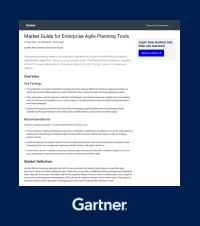Why your IT department needs an integrated SPM & PPM solution?
IT department performance has a decisive influence on whether or not the strategic objectives of all medium-sized and large companies are achieved. This increase in the importance of IT teams results in new challenges and responsibilities, which require new processes and tools to successfully address them and contribute to the success of the company they serve.
A higher volume of demand to manage, limited resources, ever-shortening deadlines, define the prioritization of initiatives according to the value they deliver to the organization…These are some of the issues that you, as head of the IT department of the organization, have to coordinate on a daily basis when managing your project portfolio. Fortunately, most of the PPM software on the market covers these issues satisfactorily.
However, what if your company changes its strategic objectives? Do you have processes and tools to adjust, in an agile, scalable and real-time manner, issues such as resource allocation, budget or demand management, and align them to the organization’s strategic objectives? Do you have in place mechanisms with which to efficiently communicate these changes to all the teams that make up the IT department?
Aligning the portfolio with strategic objectives is the major challenge faced by IT departments today. And having software that has integrated functionalities for both Project Portfolio management (PPM) and Strategy Portfolio Management (SPM) is critical for the success of your organization.
TABLE OF CONTENTS
- The new challenges in Project Portfolio management.
- The rise of digitalization in all industries.
- The world is now Agile.
- The importance of strategic alignment.
- What is SPM (Strategic Portfolio Management)?
- Benefits of Strategic Portfolio Management for your PPM solution.
- Strategic and operational planning.
- Allocation of resources and funds based on your strategic goals.
- Decision-making based on real-time data analysis.
- Increased performance and profitability.
- Eliminate organizational silos.
- Triskell Software, the solution that integrates SPM & PPM functionalities in one single place.
The new challenges in Project Portfolio management
Unfortunately, there is very few PPM software with which you can also get a strategic view of portfolio management. There have been many changes in project portfolio management over the last 10 years. And most of the PPM software vendors on the market have been unable or reluctant to develop features to adapt their solutions to the new strategic and governance challenges that IT team managers face.
Three new challenges have led to significant changes in the management of the project portfolio:
- The rise of digitalization in all industries.
- The world is now Agile.
- The importance of strategic alignment.
1. The rise of digitalization in all industries
Digitalization has completely changed the face of organizations and the way project portfolios are being planned and managed. All industries have become more competitive, and companies must bring to market more technologically advanced products and services in order to:
- Not to lose competitiveness with its immediate competitors.
- Meet the demands of increasingly well-informed consumers who want products and services tailored to their needs.
Digitalization has also changed the rules of market competition
Digitalization has also changed the rules of the game when it comes to market competition. As the competitiveness within each industry increases, so do the business opportunities. Thanks to digitalization and the rise of knowledge areas such as Big Data, Business Intelligence, IoT or UX/CX, it is easier to identify solutions that meet the needs of users and bring enormous benefits to the companies that develop them.
On the other hand, we cannot ignore the changes that digitalization has brought to the way we work and communicate on a daily basis. Instant messaging or videoconferencing applications are replacing more traditional forms of communication such as e-mail or face-to-face meetings. And the generalization of the Internet and fiber optics has allowed teleworking to consolidate.
2. The world is now Agile
The need for companies to bring new products and services to the market in ever shorter time cycles has also contributed to the emergence of Agile working methodologies. Agility is based on the sequence of several short work cycles (sprints, iterations, etc.) designed in such a way that teams can iterate until they come up with the right solution.
Both work approaches can coexist within the same IT department:
- Agile methodologies can be better suited to the dynamics of the organization’s development and operations teams.
- However, the Waterfall approach is best suited to those layers of the organization where planning, management and execution of its strategy are involved.
The coexistence of both ways of working and the adoption of this new Agile approach in portfolio management is key to the success of organizations, as it will allow them to react much more flexibly to unforeseen changes in strategy.
See the Triskell platform in action in a personal demo
The importance of strategic alignment
Therefore, in this new context, it is more important than ever that all levels of the organization are aligned with the strategic planning and objectives. Companies are forced to change their roadmap and redefine their objectives in ever shorter timeframes either to avoid missing market opportunities or to exploit growth opportunities that they have been able to identify.
All levels of the organization must be aligned with the strategic objectives
To achieve this, the IT department must have processes and tools with which to align, in real-time, its decision-making processes at the level of operations, projects and programs to the strategic objectives of the organization.
Not having these mechanisms in place to align strategic planning with execution can have negative consequences for organizations:
- Prioritization of projects not based on the value they really bring to the organization.
- Inefficient resource management and capacity planning.
- Lower productivity, which may result in loss of competitiveness in the markets.
- Lack of flexibility to adapt to unexpected changes in strategy.
- Teams working in silo
What is SPM (Strategic Portfolio Management)?
Most of the PPM software available on the market today do not have specific functionalities with which to manage, besides the organization’s project portfolio, the execution of the company’s strategy.
Surely you are using a PPM solution in your IT department to manage relevant aspects of your project portfolio such as:
- Prioritization of projects, products, programs and portfolios.
- Resources (and how they are allocated across the portfolio).
- Budgets.
- Costs.
- Create reports for the different stakeholders.
- Etc.
However, not having a strategic vision when executing the portfolio will make its management inefficient and lead to lower profits and lower productivity. Therefore, it is essential that your PPM software has SPM functionalities integrated into its interface in order to have a strategic vision of portfolio management.
SPM connects the strategic objectives of the business with its execution
Probably you may be asking yourself, what is SPM? Strategic Portfolio Management is the combination of processes and tools that connect the strategic objectives of the business with the execution of this strategy.
In today’s digital era, organizations must have mechanisms in place not only to develop medium- and long-term plans that result in strategic objectives and roadmaps, but also to adapt the execution of their strategy in response to possible changes in business strategy.
Therefore, in order to meet the strategic and governance challenges faced by IT departments, PPM software should have specific functionalities that allow to define and manage, in an agile and flexible way:
- Strategic goals and objectives.
- The prioritization of projects, programs and portfolios based on the value they deliver to the organization.
- Resource management and capacity planning.
- Costs, risks, and budgets.
Benefits of Strategic Portfolio Management for your PPM solution
Efficient portfolio management requires a strategic vision of the portfolio. Therefore, it is essential for the IT department to have a software with integrated PPM and SPM functionalities. There are many benefits that this type of tools can bring you, which can be summarized in 5 points.
1. Strategic and operational planning
Any PPM solution allows you to score projects based on their value and importance to the organization. But few of them allow linking all portfolio deliverables to the organization’s strategic objectives.
Very few PPM software allow linking portfolio deliverables to organizational objectives
Well, if your PPM software has SPM functionalities integrated, you will be able to manage the execution of your strategy more efficiently. You will be able not only to create and define strategic objectives in the tool itself, but you will also score projects according to the objectives to which they are linked.
Thus, for example, if an objective moves to a lower priority for the organization, the objects linked to that objective will be scored according to the new priority level. The same applies if it is the other way around, allowing you to manage your portfolio in line with your strategy on key issues such as budget allocation and resource management.
2. Allocation of resources and funds based on your strategic goals
One of the biggest challenges for any IT department is dealing with the increasing volume of demand with a limited number of resources and budget. In this sense, having a tool that offers a vision of the strategic management of the portfolio will greatly facilitate your decision-making.
You will be able to allocate resources or funds to the organization’s projects, products and initiatives according to the objectives, and leverage them according to the possible changes in strategy that may occur.
3. Decision-making based on real-time data analysis
Having SPM and PPM functionalities in a single solution will make it much easier for you to make decisions when managing your portfolio. The inclusion in your solution of variables based on your strategic objectives will make the analysis of all the data in your portfolio much more detailed and, therefore, your decision-making will be more aligned with your strategy.
If your PPM solution also has functionalities such as predictive data analysis and What-if scenario simulations, your department will be able to anticipate the possible changes that the organization may take. And, consequently, make adjustments in matters such as resource management, budgets, priorities and costs based on the data provided by the tool itself.
4. Increased performance and profitability
One of the biggest discussions that you, as head of the IT department, have with the executives of the organization is probably related to the costs that your area represents for the company. Costs that, in most cases, could have been better optimized if all your initiatives were focused on continuous value delivery and aligned with the organization’s strategic objectives.
With a PPM & SEM software you will focus on the projects that bring value to the organization
With a PPM software with SPM functionalities, you will ensure that the IT department and all the teams that compose it focus their efforts on the projects and initiatives that really add value to the organization. Your activities will be more profitable and productive for the organization, and executives will see you as an area that truly adds value to the business.
5. Eliminate organizational silos
Nothing is more important to achieve strategic objectives than having all teams informed and committed to achieve them. One of the main challenges faced by IT departments when managing the portfolio is to put an end to the siloed teams or individuals.
A PPM software with integrated SEM functionalities will make the end of silos in your organization tangible. You will be able to create objectives that can be extrapolated to all levels of the organization, thus putting strategy at the center of all the actions of your IT teams.
Triskell Software, the solution that integrates SPM & PPM functionalities in one single place
Among all the solutions on the market, Triskell Software platform is the one that best solves all the management and governance issues that IT departments face when planning, managing and executing their portfolio of projects and/or products.
Subscribe to our Newsletter
Get stories like this in your inbox
Request a demo of Triskell Software
Triskell Software is the flexible solution you need to align portfolio management and execution with your organization’s goals and strategic vision. Check it out for yourself by requesting a demo.

Related Content

Why the CIO needs a PMO approach
Unlock business success: discover why the CIO must embrace a PMO approach! to elevate efficiency and boost productivity.

Lean Budgeting for Agile Portfolios: A Comprehensive Guide
Lean Budgeting: the financial revolution for Agile portfolios. Discover how to streamline project financing and optimize value delivery.

Implementing SAFe with a 7-step roadmap
Do you want to scale Agile at the enterprise level and don’t know where to start? We solve your doubts by explaining the steps to implement SAFe.

